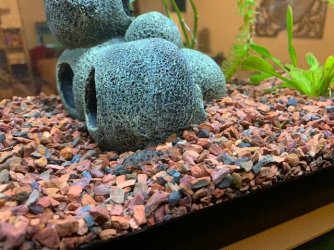Ken Sauer
Fish Fanatic
Approximately 2 months ago, I purchased 6 young corys and put them in a 10 gallon quarantine tank. After quarantine, I added them to my 125 gallon community tank. Then, I got 4 more young guys and put them in the 10 gallon. Within a week, one of the 4 got a bladder infection. I took the the other 3 out of the 10 and put them in the 125 and treated the guy with the bladder infection. A day later, I found a cory near-dead on the bottom of the 125. He died. The rest of my corys looked healthy at this time, so I decided to take the dead one and the one with the bladder infection back to the lfs.
A week later, another cory died...found him barely breathing on the bottom of the 125. The next week I found another cory in the same situation. A few days later another died.
In speaking to the lfs, they said that perhaps, the corys, since they are so young are having a hard time getting enough to eat (in the 125 I have 8 zebra danios, 7 cherry barbs, 12 candy canes) with competition for food and all. So, I moved the remaining 5 corys back to the 10 gallon tank. The all seemed healthy at the time. 3 or so days ago, one of them started acting funky and mopey. He eventually died the same way the others died. Now, I am down to 4 corys. Obviously, I am trying hard to keep them alive. They are all in the 10 gallon. The perimeters in both my tanks are perfect and have been the whole time.
I caught the one I took pictures of looking a bit mopey this morning and it made me worry that, in a few days, he will be dead at the bottom of the tank.
So....here are some pictures of the one acting a bit mopey.
Does anyone see anything obviously wrong with this guy?
All suggestions are appreciated.
Thanks.
A week later, another cory died...found him barely breathing on the bottom of the 125. The next week I found another cory in the same situation. A few days later another died.
In speaking to the lfs, they said that perhaps, the corys, since they are so young are having a hard time getting enough to eat (in the 125 I have 8 zebra danios, 7 cherry barbs, 12 candy canes) with competition for food and all. So, I moved the remaining 5 corys back to the 10 gallon tank. The all seemed healthy at the time. 3 or so days ago, one of them started acting funky and mopey. He eventually died the same way the others died. Now, I am down to 4 corys. Obviously, I am trying hard to keep them alive. They are all in the 10 gallon. The perimeters in both my tanks are perfect and have been the whole time.
I caught the one I took pictures of looking a bit mopey this morning and it made me worry that, in a few days, he will be dead at the bottom of the tank.
So....here are some pictures of the one acting a bit mopey.
Does anyone see anything obviously wrong with this guy?
All suggestions are appreciated.
Thanks.










